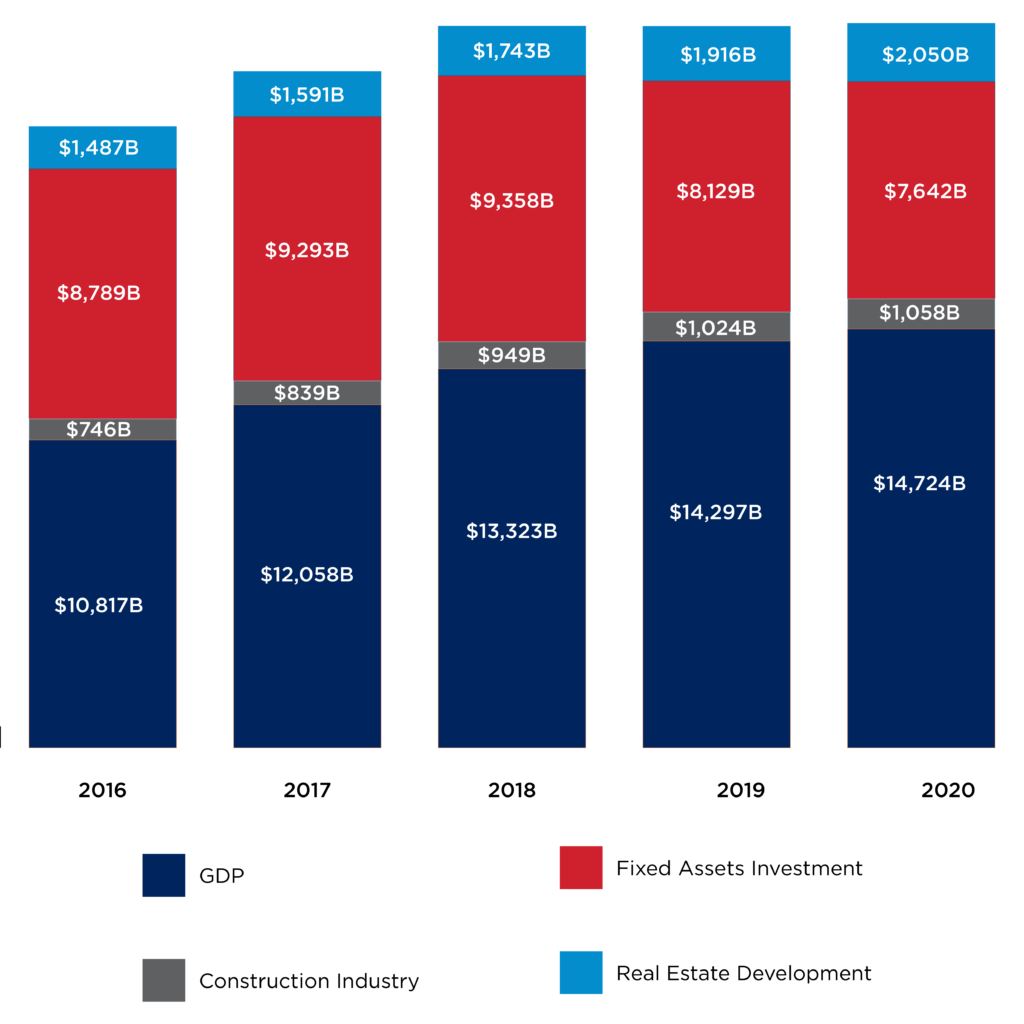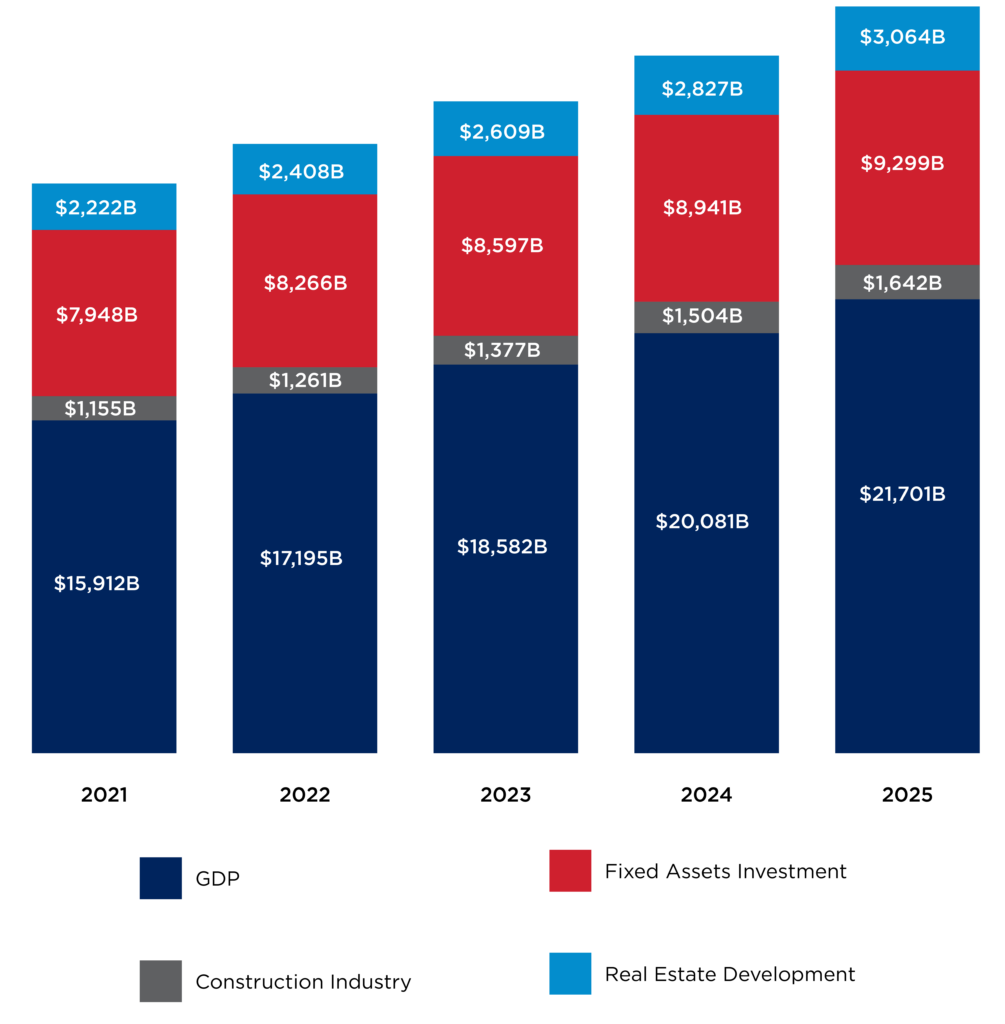In China, the Five-Year Plan is a series of social and economic development issued by the government to govern the national major construction projects, productivity distribution, and main proportion of the national economy. By the end of 2020, China has already accomplished 13 Five-Year Plans.
In the past ten years, China’s GDP saw an average growth of 10% under the plans. Amid the COVID-19 crisis in 2020, China has still achieved positive economic growth. In the 13th Five-Year Plan period, the construction industry expanded 5.1% annually in added value, accounting for 7% of GDP. And the investment in real estate development accounted for 20% average of investment in fixed assets, as shown in Figure 1. It is apparent that China’s construction industry has played an increasingly important role in bolstering the economy, preventing and resolving various risks. The outline of the 14th Five-Year Plan launched in 2021 sets forth the China’s GDP growth has to be kept within a reasonable range in the next fifteen years. Although the outline does not set a specific annual GDP growth target, we can predict the growth from 2021 to 2025 by analyzing historical data. As shown in Figure 2, the GDP in the construction industry and the investment scale of real estate development are expected to reach USD 1.6 trillion and USD 3 trillion respectively by 2025.
Figure 1: The GDP data and other construction-related data during the 13th Five-Year Plan period from 2016 to 2020

Source: National Bureau of Statistics, China
Figure 2: The GDP data and other construction-related data during the 14th Five-Year Plan period from 2021 to 2025

It is worth mentioning that this outline does not give specific growth targets since China is gradually shifting its focus from economic development to high-quality development. The latest Five-Year Plan specifies high-quality development, which is innovation-driven and taken from a sustainable approach, will be one of the underlying themes during China’s development in coming years.
Pursuing High Quality Development in Construction Industry
As a pillar sector of the country, China has further unveiled a development plan in January 2022 to push construction industry of the country’s economy onto a green, smarter and safer path. The development goals for the construction industry are outlined in Table 1.
Table 1: The development goals during the 14th Five-Year Plan period
| Contents | Requirements |
|---|---|
| Added value of construction industry account of GDP | 6% |
| Prefabricated buildings account of the new construction | ≥30% |
| Building waste at new construction sites | ≤300 tons/10,000m2 |
| Promote the use of information technologies | |
| Promote the application of construction robots in some fields |
Source: Ministry of Housing and Urban-Rural Development, China
Together with China’s sustainable goals to achieve carbon peak by 2030 and carbon neutrality by 2060, the plan adopts a number of measures to promote green buildings and intelligent construction in this industry. The following list highlights some of the key initiatives in this plan.
- Implement and promote the use the reflective insulation (silicone molecule) paint system for exterior walls. This system can reduce emissions from electricity generation so as to minimize the building’s cooling energy consumption in summer and the annual energy consumption. Thus, it helps lower CO2 emissions and improve urban ecology.
- Implement and promote the use of composite wall panels for interior and exterior to greatly shorten the construction period. It has a longer product life cycle, and thus save maintenance costs.
- Promote intelligent construction. Intelligent construction integrates information technologies (such as Internet, Internet of Things, artificial intelligence and big data processing) with advanced construction technology to provide a wide range of functions at the construction site including information collection, data analysis, real-time monitoring, risk early warning and decision-making assistance. The AI systems not only help optimize construction processes and improve construction site safety, but also increase cost efficiency and uplift the quality for the construction management process.
- Internet of Things (IoT), through information sensing devices (such as video recognition, infrared sensor, GIS global positioning system and laser scanner), allows information exchange between objects and the Internet to achieve a comprehensive range of functions such as intelligent identification, positioning, tracking and management. This technology is mainly used in construction, operation and maintenance so as to uplift onsite safety management.
- The virtual reality (VR) is the use of computer technology to create a simulated environment which can be explored in 360 degrees. The integration of BIM and VR provides a more effective and convenient means for design modification and improvement in construction.
Looking Forward
With the release of the 14th Five-Year Plan, reform and innovation become the key initiatives of the construction industry. In the future, traditional construction methods will be gradually replaced by intelligent and sustainable methods, thus generating innovative construction materials, new construction technologies and processes. Digital transformation and sustainability, two of the most powerful drivers for the future of the business, will definitely help China meet its pledge to reach carbon neutrality by 2060.
FURTHER INFORMATION:


